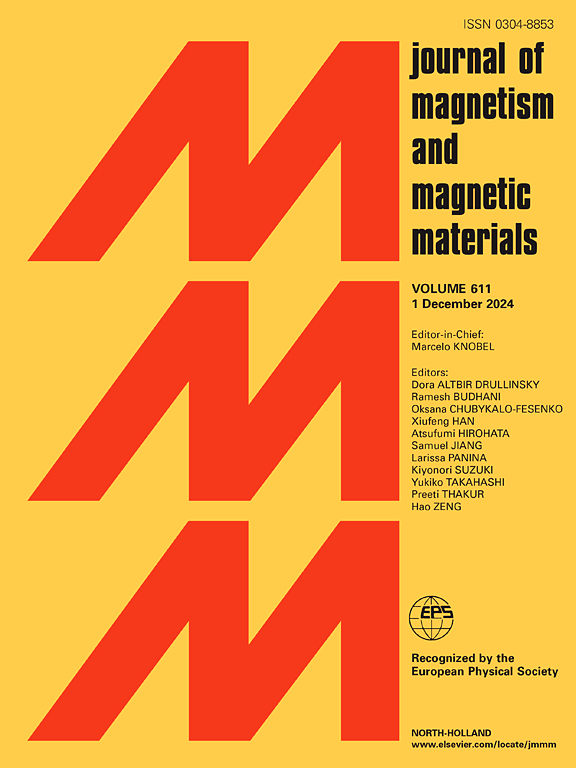Magnetic and magnetocaloric properties of the two-dimensional Ln2(phthalate)3(H2O) (Ln = Gd-Dy) framework series
IF 3
3区 材料科学
Q3 MATERIALS SCIENCE, MULTIDISCIPLINARY
引用次数: 0
Abstract
The magnetic properties of a series of layered, two-dimensional Ln2(phth)3(H2O) (where Ln = Gd-Dy and phth = phthalate) metal–organic framework (MOF) materials have been examined to evaluate their potential as magnetocaloric materials. The Gd2(phth)3(H2O) material was found to exhibit the best performance of the series with a −ΔSmmax of 16.3 J kg−1 K−1 for a magnetic field change of 5–0 T. Although modest compared to other Gd-based magnetocaloric frameworks, this material was notable for exhibiting its peak entropy change at 4 K. This contrasts with the majority of Gd-based magnetocaloric materials whose performance is usually optimised at 2 K (or lower) and found to rapidly decrease with increasing temperature and is attributed to the stronger magnetic interactions present in this material.
二维Ln2(邻苯二甲酸盐)3(H2O) (Ln = Gd-Dy)骨架系列的磁性和磁热学性质
研究了一系列层状二维Ln2(phth)3(H2O)(其中Ln = Gd-Dy和phth =邻苯二甲酸盐)金属有机框架(MOF)材料的磁性能,以评估其作为磁热材料的潜力。在该系列中,Gd2(phth)3(H2O)材料表现出最好的性能,当磁场变化为5-0 t时,Gd2(phth)3(H2O)材料的- ΔSmmax为16.3 J kg−1 K−1,尽管与其他基于gd的磁热框架相比,该材料的熵变峰值在4 K时是显著的。这与大多数基于gd的磁热材料形成对比,这些材料的性能通常在2k(或更低)时优化,并且发现随着温度的升高而迅速下降,这归因于该材料中存在更强的磁相互作用。
本文章由计算机程序翻译,如有差异,请以英文原文为准。
求助全文
约1分钟内获得全文
求助全文
来源期刊

Journal of Magnetism and Magnetic Materials
物理-材料科学:综合
CiteScore
5.30
自引率
11.10%
发文量
1149
审稿时长
59 days
期刊介绍:
The Journal of Magnetism and Magnetic Materials provides an important forum for the disclosure and discussion of original contributions covering the whole spectrum of topics, from basic magnetism to the technology and applications of magnetic materials. The journal encourages greater interaction between the basic and applied sub-disciplines of magnetism with comprehensive review articles, in addition to full-length contributions. In addition, other categories of contributions are welcome, including Critical Focused issues, Current Perspectives and Outreach to the General Public.
Main Categories:
Full-length articles:
Technically original research documents that report results of value to the communities that comprise the journal audience. The link between chemical, structural and microstructural properties on the one hand and magnetic properties on the other hand are encouraged.
In addition to general topics covering all areas of magnetism and magnetic materials, the full-length articles also include three sub-sections, focusing on Nanomagnetism, Spintronics and Applications.
The sub-section on Nanomagnetism contains articles on magnetic nanoparticles, nanowires, thin films, 2D materials and other nanoscale magnetic materials and their applications.
The sub-section on Spintronics contains articles on magnetoresistance, magnetoimpedance, magneto-optical phenomena, Micro-Electro-Mechanical Systems (MEMS), and other topics related to spin current control and magneto-transport phenomena. The sub-section on Applications display papers that focus on applications of magnetic materials. The applications need to show a connection to magnetism.
Review articles:
Review articles organize, clarify, and summarize existing major works in the areas covered by the Journal and provide comprehensive citations to the full spectrum of relevant literature.
 求助内容:
求助内容: 应助结果提醒方式:
应助结果提醒方式:


